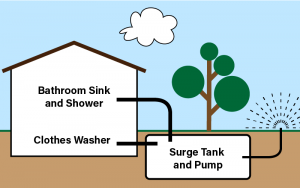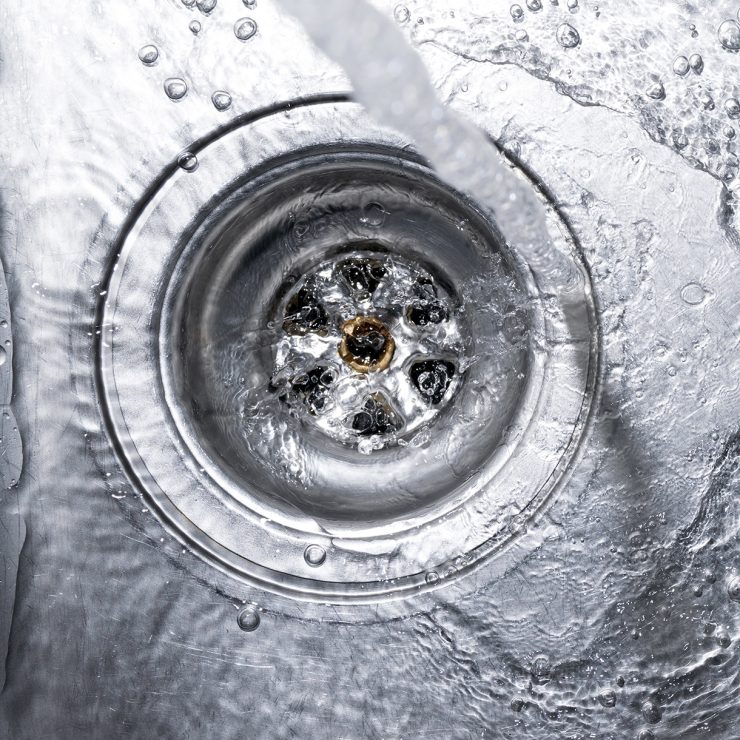By: Diana Gutierrez and Brittany Kwolek
As children, we grew up learning about the 3 R’s: Reduce, Reuse, and Recycle. On May 15th, 2018 a bill [1] was signed into law (§9–1112) [2] by Governor Hogan helping Maryland residents focus on the second R, Reuse. The law authorizes the use of graywater on residential properties.
Graywater is defined in the bill as, “used, untreated water generated by the use of and collection from a shower, a bathtub or a lavatory sink,” and excludes water from sources such as toilets, kitchen sinks, and dishwashers. These established sources of graywater can be used for purposes such as gardening, composting, lawn watering, landscape irrigation, and toilet flushing (under certain circumstances). The law was designed with limitations on graywater use to ensure its use does not cause harm to humans or the environment. For example, graywater cannot come from sources that may contain hazardous chemicals, be used to irrigate food plants, or be allowed to run off into natural water bodies.
Why use a Graywater system?
Since graywater can be used in many applications that potable water can be used, it has many benefits to homeowners as well as the environment. Homeowners who install graywater systems can usually expect to see a reduction in their water bill, as the recycled water is used to complete tasks that would otherwise use potable water from a city well, for example. The upgrade can even increase property values. Homeowners in drought prone areas will also be able to maintain their landscaping and gardens through times where water is limited. Likewise, this practice also helps to reduce depletion of underground aquifers and freshwater bodies used to provide water to municipalities As graywater systems reduce the need for this drawdown, the security of future water supplies is increased. By reusing domestic water supplies, graywater systems help to divert wastewater from local water treatment facilities, at least temporarily, thus helping to reduce energy and other associated resource demand.
How to implement a Graywater system?
There are a variety of options available to fit all needs and restrictions of homeowners, and some site assessment should be done to determine which system best fits the residence. Graywater should not be stored long-term, since it will eventually smell. The simplest way to combat this is through piping graywater directly outdoors using gravity instead of pumps. This “Laundry to Landscape” method connects wash water to a diverter, allowing the homeowner to choose whether the water goes to sewer and septic, or to the graywater irrigation system and directly to your garden. If needed, drums or surge tanks can be used to store graywater short term as the water is slowly released out the bottom of the tank through a hose. When a household produces more graywater than needed for irrigation, systems such as constructed wetlands can be used. The wetland naturally absorbs and filters the nutrients and particles out of the water. This system is also a good alternative if a home is situated too close to a natural water body.
and restrictions of homeowners, and some site assessment should be done to determine which system best fits the residence. Graywater should not be stored long-term, since it will eventually smell. The simplest way to combat this is through piping graywater directly outdoors using gravity instead of pumps. This “Laundry to Landscape” method connects wash water to a diverter, allowing the homeowner to choose whether the water goes to sewer and septic, or to the graywater irrigation system and directly to your garden. If needed, drums or surge tanks can be used to store graywater short term as the water is slowly released out the bottom of the tank through a hose. When a household produces more graywater than needed for irrigation, systems such as constructed wetlands can be used. The wetland naturally absorbs and filters the nutrients and particles out of the water. This system is also a good alternative if a home is situated too close to a natural water body.
Ultimately a homeowner must know their backyard ecosystem, including the specific needs of the soils and plants found there. For example, knowing the draining capabilities of the soil is very important as no pooling of graywater is allowed due to health concerns. The simplest methods are usually the most effective and can save homeowners money and benefit the environment in the long term.
MDE will be developing guidance to implement the new regulation in the near future. Until then, you can always focus on the most important of the 3R’s – reducing the amount of water you use.
[1] http://mgaleg.maryland.gov/webmga/frmMain.aspx?pid=billpage&tab=subject3&id=sb0496&stab=01&ys=2018RS
[2] http://mgaleg.maryland.gov/webmga/frmStatutesText.aspx?article=gen§ion=9-1112&ext=html&session=2020RS&tab=subject5
